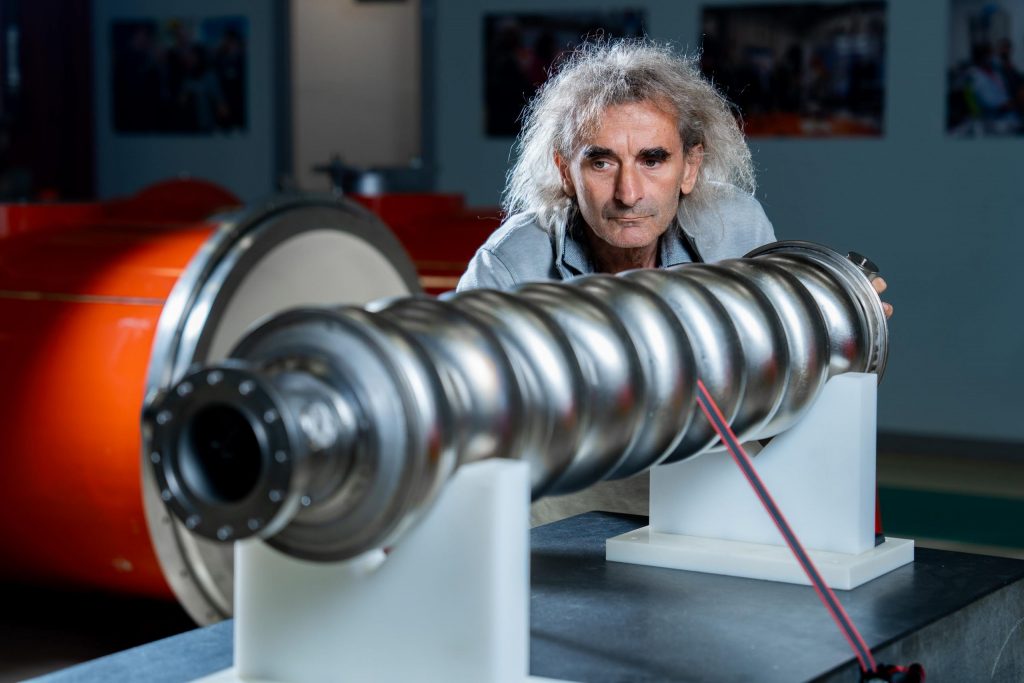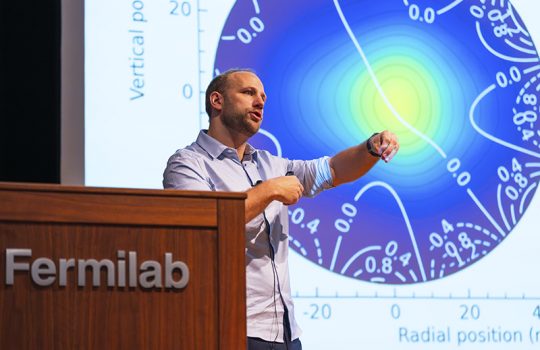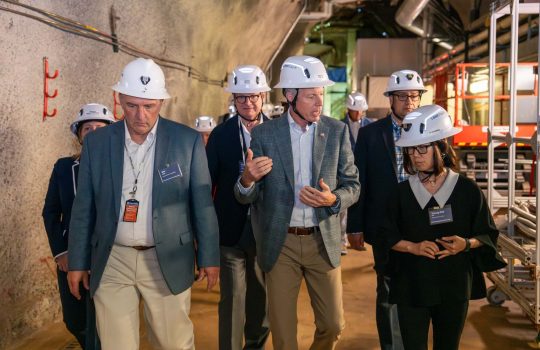Pantaleo Raimondi has long been fascinated by how things work.
“I like to understand everything. I don’t want to leave anything unexplored,” Raimondi said. “Even in a car, I try to understand exactly all the pieces that are there, why they work, and so on.”
It made some sense, then, that Raimondi opted to pursue a career in physics. “Physics really gives you a lot of answers,” he added.

Physicist Pantaleo Raimondi is the new project director for the PIP-II collaboration that is upgrading the accelerator complex at Fermilab. Photo: Dan Svoboda, Fermilab
But when he decided to come to Fermilab, America’s premier particle and accelerator physics laboratory, Raimondi said it was for the people.
“I have a good experience working in teams,” said the Italian accelerator physicist. “Since I have joined many, many teams in my life, I know how teams are, at a glance. And here at Fermilab, when I came, I realized that the team here is really beautiful.”
Raimondi is the new project director for the Proton Improvement Plan II. The PIP-II collaboration is upgrading the accelerator complex at the U.S. Department of Energy’s Fermi National Accelerator Laboratory, just outside of Chicago. To do this, a new superconducting linear accelerator is being constructed that will eventually send neutrinos to the Deep Underground Neutrino Experiment, enabling the advancement of neutrino physics for decades to come.
“Throughout my life, I’ve always been attracted by new experiments, new challenges, new projects,” he said. “I prefer to stay in one place, but then something else shows up and, somehow, I get attracted. This is true as well for PIP-II.”
“Leading PIP-II is a very challenging endeavor,” said Cristian Boffo, PIP-II project manager. “The technology that is being developed for the machine is beyond state of the art. Over 300 people from all Fermilab directorates work on PIP-II every day, and international partners from five countries provide significant in-kind components and share invaluable knowhow.”
“But in the few months since he joined Fermilab, Pantaleo has fully integrated into the team,” Boffo added. “He has begun providing precious guidance in key areas of the project and has set the pace for the years to come.”

“Throughout my life, I’ve always been attracted by new experiments, new challenges, new projects.” Photo: Dan Svoboda, Fermilab
The path to Fermilab
Raimondi did his graduate studies as part of the ALEPH particle detector collaboration at CERN in Switzerland. After earning his Ph.D., Raimondi went back and forth between a research center for the Italian National Agency for New Technologies, Energy and Sustainable Economic Development in Frascati, Italy, and SLAC National Accelerator Laboratory in Menlo Park, California.
Throughout this earlier part of his career, he worked on the design and development of radiofrequency power systems, theoretical and technical analyses of linear accelerators and microtrons, beam transport studies and other topics related to electron accelerators, beam-based alignment and final-focus systems.
Later, Raimondi was appointed head of the accelerator division at Italy’s National Institute for Nuclear Physics National Laboratory of Frascati in Rome. There, he participated in commissioning DAFNE, an electron-positron collider. Raimondi contributed to improving the understanding and performance of DAFNE and developed new techniques to improve its luminosity.
Most recently, Raimondi was based in Grenoble, France, at the European Synchrotron Radiation Facility. There, he led the upgrade of the ESRF synchrotron ring, building the brightest synchrotron source in the world — 100 times more powerful than its predecessor. His revolutionary design of the synchrotron’s “extremely brilliant source” is now being replicated by all major synchrotron light sources around the world, including Raimondi’s new neighbors at Argonne National Laboratory. Raimondi even spent time in Switzerland to discuss his lessons learned with CERN scientists to inform the development of their Future Circular Collider.
In January, Raimondi moved to the Chicago area and officially joined Fermilab. He was preceded by Rich Stanek, who had served as the interim director of PIP-II since April 2022.
Raimondi’s first taste of a Chicago winter didn’t faze him; he said that he likes the snow and the cold. In general, Raimondi enjoys spending time in nature and likes sports “of any kind.” So far, he said he’s done a lot of bicycling and running.
But some of his favorite activities cultivated in the French Alps, on the Italian coast and in California’s Bay Area are harder to do in Batavia — for example, paragliding, mountain climbing, surfing and wind surfing. “But,” he joked, “it’s good, because then I will focus more on working.”
Steering the boat
With his expertise in running projects in many different phases, Raimondi said he was comfortable jumping into a project that’s already moving along. “When I joined the project, it was in a very advanced state, and it’s doing very, very well,” he said.
In his first few months on the job, Raimondi said he’s trying to absorb a fire hose of new information. “I’m getting acquainted and trying to not do many stupid things,” he said.
“You can say that the project is like a big, huge boat. … At this stage, what is really important is removing the rocks, the obstacles from the path of the boat,” he said.
As one of Fermilab’s flagship projects, PIP-II has a never-ending stream of tasks for Raimondi to keep an eye on. The PIP-II site at Fermilab is under construction, new technology is being developed and components of the accelerator are being assembled and tested. For example, the team is assessing a prototype cryomodule after it was shipped to the United Kingdom and back to validate its transportation system; at the same time, they are preparing to assemble another unit in the newly qualified clean room at Fermilab.
“Pantaleo joined PIP-II at the right time,” said Allan Rowe, PIP-II technical integration manager. “As the project wraps up all final design activities, pushes through the procurement phase and begins detailed integration and commissioning planning, his experience from leading these efforts at ESRF and elsewhere will be invaluable.”
Raimondi thinks PIP-II is already “pretty solid.” As with any large project, there will be “ordinary challenges” related to executing the project on time and on budget. However, Raimondi assures that he and his team will get the new linear accelerator — and the physics results — done, no matter what.
As for the people, Raimondi is still impressed by the PIP-II team.
“Knowing more and more about my colleagues is a confirmation of my first impression,” he said. “I’m really looking forward to continuing.”
Fermi National Accelerator Laboratory is supported by the Office of Science of the U.S. Department of Energy. The Office of Science is the single largest supporter of basic research in the physical sciences in the United States and is working to address some of the most pressing challenges of our time. For more information, please visit science.energy.gov.



